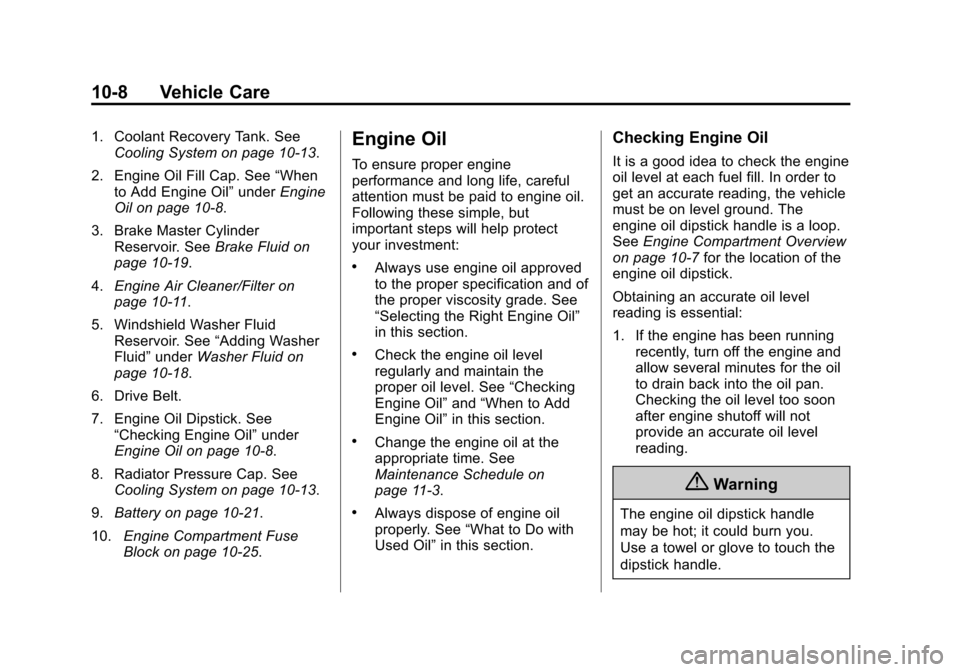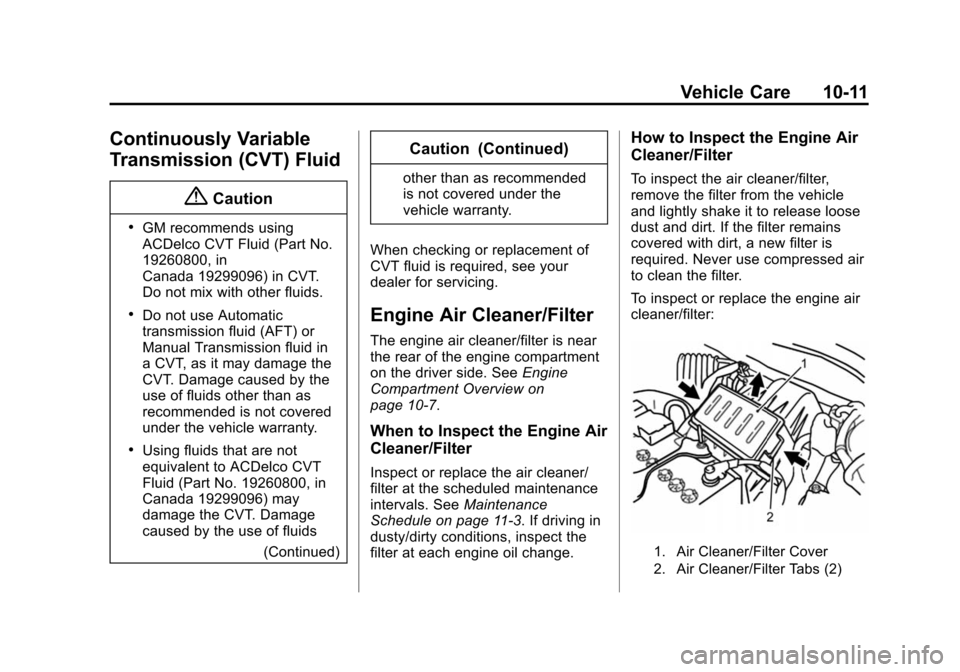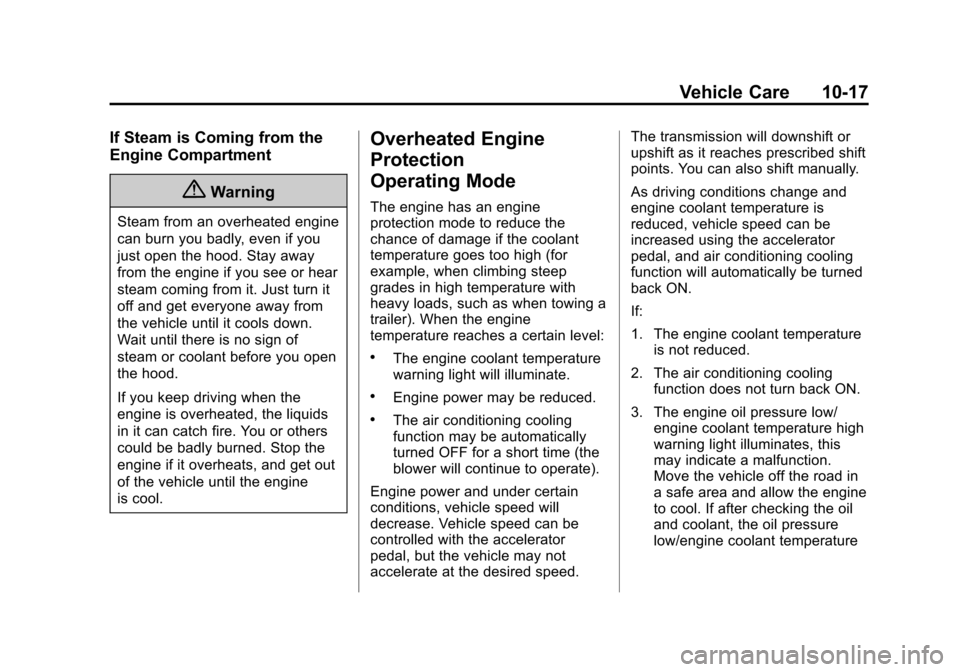checking oil CHEVROLET CITY EXPRESS CARGO VAN 2016 1.G Owners Manual
[x] Cancel search | Manufacturer: CHEVROLET, Model Year: 2016, Model line: CITY EXPRESS CARGO VAN, Model: CHEVROLET CITY EXPRESS CARGO VAN 2016 1.GPages: 297, PDF Size: 4.32 MB
Page 191 of 297

Black plate (8,1)Chevrolet City Express Owner Manual (GMNA-Localizing-U.S./Canada-
7707496) - 2015 - CRC - 11/26/14
10-8 Vehicle Care
1. Coolant Recovery Tank. SeeCooling System on page 10-13.
2. Engine Oil Fill Cap. See “When
to Add Engine Oil” underEngine
Oil on page 10-8.
3. Brake Master Cylinder Reservoir. See Brake Fluid on
page 10-19.
4. Engine Air Cleaner/Filter on
page 10-11.
5. Windshield Washer Fluid Reservoir. See “Adding Washer
Fluid” under Washer Fluid on
page 10-18.
6. Drive Belt.
7. Engine Oil Dipstick. See “Checking Engine Oil” under
Engine Oil on page 10-8.
8. Radiator Pressure Cap. See Cooling System on page 10-13.
9. Battery on page 10-21.
10. Engine Compartment Fuse
Block on page 10-25.Engine Oil
To ensure proper engine
performance and long life, careful
attention must be paid to engine oil.
Following these simple, but
important steps will help protect
your investment:
.Always use engine oil approved
to the proper specification and of
the proper viscosity grade. See
“Selecting the Right Engine Oil”
in this section.
.Check the engine oil level
regularly and maintain the
proper oil level. See “Checking
Engine Oil” and“When to Add
Engine Oil” in this section.
.Change the engine oil at the
appropriate time. See
Maintenance Schedule on
page 11-3.
.Always dispose of engine oil
properly. See “What to Do with
Used Oil” in this section.
Checking Engine Oil
It is a good idea to check the engine
oil level at each fuel fill. In order to
get an accurate reading, the vehicle
must be on level ground. The
engine oil dipstick handle is a loop.
SeeEngine Compartment Overview
on page 10-7 for the location of the
engine oil dipstick.
Obtaining an accurate oil level
reading is essential:
1. If the engine has been running recently, turn off the engine and
allow several minutes for the oil
to drain back into the oil pan.
Checking the oil level too soon
after engine shutoff will not
provide an accurate oil level
reading.
{Warning
The engine oil dipstick handle
may be hot; it could burn you.
Use a towel or glove to touch the
dipstick handle.
Page 194 of 297

Black plate (11,1)Chevrolet City Express Owner Manual (GMNA-Localizing-U.S./Canada-
7707496) - 2015 - CRC - 11/26/14
Vehicle Care 10-11
Continuously Variable
Transmission (CVT) Fluid
{Caution
.GM recommends using
ACDelco CVT Fluid (Part No.
19260800, in
Canada 19299096) in CVT.
Do not mix with other fluids.
.Do not use Automatic
transmission fluid (AFT) or
Manual Transmission fluid in
a CVT, as it may damage the
CVT. Damage caused by the
use of fluids other than as
recommended is not covered
under the vehicle warranty.
.Using fluids that are not
equivalent to ACDelco CVT
Fluid (Part No. 19260800, in
Canada 19299096) may
damage the CVT. Damage
caused by the use of fluids(Continued)
Caution (Continued)
other than as recommended
is not covered under the
vehicle warranty.
When checking or replacement of
CVT fluid is required, see your
dealer for servicing.
Engine Air Cleaner/Filter
The engine air cleaner/filter is near
the rear of the engine compartment
on the driver side. See Engine
Compartment Overview on
page 10-7.
When to Inspect the Engine Air
Cleaner/Filter
Inspect or replace the air cleaner/
filter at the scheduled maintenance
intervals. See Maintenance
Schedule on page 11-3. If driving in
dusty/dirty conditions, inspect the
filter at each engine oil change.
How to Inspect the Engine Air
Cleaner/Filter
To inspect the air cleaner/filter,
remove the filter from the vehicle
and lightly shake it to release loose
dust and dirt. If the filter remains
covered with dirt, a new filter is
required. Never use compressed air
to clean the filter.
To inspect or replace the engine air
cleaner/filter:
1. Air Cleaner/Filter Cover
2. Air Cleaner/Filter Tabs (2)
Page 200 of 297

Black plate (17,1)Chevrolet City Express Owner Manual (GMNA-Localizing-U.S./Canada-
7707496) - 2015 - CRC - 11/26/14
Vehicle Care 10-17
If Steam is Coming from the
Engine Compartment
{Warning
Steam from an overheated engine
can burn you badly, even if you
just open the hood. Stay away
from the engine if you see or hear
steam coming from it. Just turn it
off and get everyone away from
the vehicle until it cools down.
Wait until there is no sign of
steam or coolant before you open
the hood.
If you keep driving when the
engine is overheated, the liquids
in it can catch fire. You or others
could be badly burned. Stop the
engine if it overheats, and get out
of the vehicle until the engine
is cool.
Overheated Engine
Protection
Operating Mode
The engine has an engine
protection mode to reduce the
chance of damage if the coolant
temperature goes too high (for
example, when climbing steep
grades in high temperature with
heavy loads, such as when towing a
trailer). When the engine
temperature reaches a certain level:
.The engine coolant temperature
warning light will illuminate.
.Engine power may be reduced.
.The air conditioning cooling
function may be automatically
turned OFF for a short time (the
blower will continue to operate).
Engine power and under certain
conditions, vehicle speed will
decrease. Vehicle speed can be
controlled with the accelerator
pedal, but the vehicle may not
accelerate at the desired speed. The transmission will downshift or
upshift as it reaches prescribed shift
points. You can also shift manually.
As driving conditions change and
engine coolant temperature is
reduced, vehicle speed can be
increased using the accelerator
pedal, and air conditioning cooling
function will automatically be turned
back ON.
If:
1. The engine coolant temperature
is not reduced.
2. The air conditioning cooling function does not turn back ON.
3. The engine oil pressure low/ engine coolant temperature high
warning light illuminates, this
may indicate a malfunction.
Move the vehicle off the road in
a safe area and allow the engine
to cool. If after checking the oil
and coolant, the oil pressure
low/engine coolant temperature